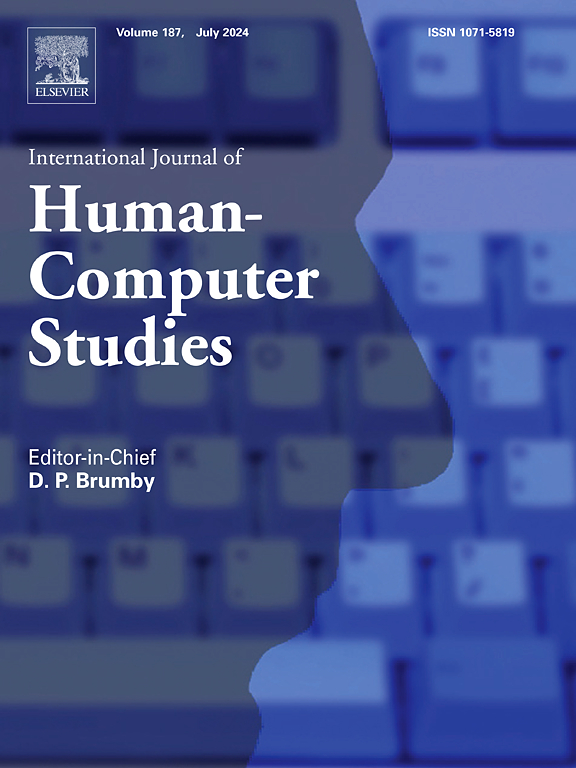Information that matters: Exploring information needs of people affected by algorithmic decisions
IF 5.3
2区 计算机科学
Q1 COMPUTER SCIENCE, CYBERNETICS
International Journal of Human-Computer Studies
Pub Date : 2024-09-26
DOI:10.1016/j.ijhcs.2024.103380
引用次数: 0
Abstract
Every AI system that makes decisions about people has a group of stakeholders that are personally affected by these decisions. However, explanations of AI systems rarely address the information needs of this stakeholder group, who often are AI novices. This creates a gap between conveyed information and information that matters to those who are impacted by the system’s decisions, such as domain experts and decision subjects. To address this, we present the “XAI Novice Question Bank”, an extension of the XAI Question Bank (Liao et al., 2020) containing a catalog of information needs from AI novices in two use cases: employment prediction and health monitoring. The catalog covers the categories of data, system context, system usage, and system specifications. We gathered information needs through task based interviews where participants asked questions about two AI systems to decide on their adoption and received verbal explanations in response. Our analysis showed that participants’ confidence increased after receiving explanations but that their understanding faced challenges. These included difficulties in locating information and in assessing their own understanding, as well as attempts to outsource understanding. Additionally, participants’ prior perceptions of the systems’ risks and benefits influenced their information needs. Participants who perceived high risks sought explanations about the intentions behind a system’s deployment, while those who perceived low risks rather asked about the system’s operation. Our work aims to support the inclusion of AI novices in explainability efforts by highlighting their information needs, aims, and challenges. We summarize our findings as five key implications that can inform the design of future explanations for lay stakeholder audiences.

重要信息:探索受算法决策影响者的信息需求
每一个对人类做出决策的人工智能系统都有一群利益相关者,他们会受到这些决策的切身影响。然而,对人工智能系统的解释很少能满足这部分利益相关者的信息需求,他们往往是人工智能的新手。这就造成了所传达的信息与受系统决策影响者(如领域专家和决策主体)所关心的信息之间的差距。为了解决这个问题,我们提出了 "XAI 新手问题库",它是 XAI 问题库(廖等人,2020 年)的扩展,其中包含两个使用案例中人工智能新手的信息需求目录:就业预测和健康监测。目录涵盖了数据、系统环境、系统使用和系统规范等类别。我们通过基于任务的访谈收集信息需求,在访谈中,参与者就两个人工智能系统提出问题,以决定是否采用这两个系统,并在回答时得到口头解释。我们的分析表明,在得到解释后,参与者的信心有所增强,但他们的理解也面临挑战。这包括在查找信息和评估自己的理解方面遇到的困难,以及试图将理解外包的尝试。此外,参与者先前对系统风险和益处的看法也影响了他们对信息的需求。认为风险高的参与者希望得到系统部署背后意图的解释,而认为风险低的参与者则希望了解系统的运行情况。我们的工作旨在通过强调人工智能新手的信息需求、目的和挑战,支持他们参与可解释性工作。我们将研究结果总结为五个关键影响,这些影响可以为未来设计面向非专业利益相关者受众的解释提供参考。
本文章由计算机程序翻译,如有差异,请以英文原文为准。
求助全文
约1分钟内获得全文
求助全文
来源期刊

International Journal of Human-Computer Studies
工程技术-计算机:控制论
CiteScore
11.50
自引率
5.60%
发文量
108
审稿时长
3 months
期刊介绍:
The International Journal of Human-Computer Studies publishes original research over the whole spectrum of work relevant to the theory and practice of innovative interactive systems. The journal is inherently interdisciplinary, covering research in computing, artificial intelligence, psychology, linguistics, communication, design, engineering, and social organization, which is relevant to the design, analysis, evaluation and application of innovative interactive systems. Papers at the boundaries of these disciplines are especially welcome, as it is our view that interdisciplinary approaches are needed for producing theoretical insights in this complex area and for effective deployment of innovative technologies in concrete user communities.
Research areas relevant to the journal include, but are not limited to:
• Innovative interaction techniques
• Multimodal interaction
• Speech interaction
• Graphic interaction
• Natural language interaction
• Interaction in mobile and embedded systems
• Interface design and evaluation methodologies
• Design and evaluation of innovative interactive systems
• User interface prototyping and management systems
• Ubiquitous computing
• Wearable computers
• Pervasive computing
• Affective computing
• Empirical studies of user behaviour
• Empirical studies of programming and software engineering
• Computer supported cooperative work
• Computer mediated communication
• Virtual reality
• Mixed and augmented Reality
• Intelligent user interfaces
• Presence
...
 求助内容:
求助内容: 应助结果提醒方式:
应助结果提醒方式:


